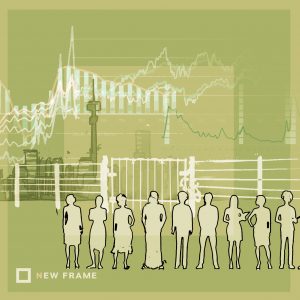South Africa needs feminist economics, now
In the second response in our New Frame, New Economy forum on women in the economy, Busi Sibeko focuses on the unpaid work women do behind the scenes and how power relations need to shift.
Author:
29 June 2021

When economists analyse people’s participation in an economy, they generally assume workers’ full-time and lifelong participation in the workforce. Most economists are not concerned with how those workers are sustained or how their households are structured. Standard economic approaches are also quiet on how power is reproduced at a state, market and household level.
So, while Nthabiseng Moleko’s article does a comprehensive job of showing women’s marginalisation within the labour market, the “gendered economy” goes well beyond this.
If we define women’s economic participation in the traditional sense of its “productive” contribution to the economy, we will undervalue it. We are also likely to miss critical changes and policy interventions that need to be made.
To fundamentally transform the economy, we must change how we think about the economy in the first place.
Women’s participation
The reduction of women’s participation in the economy to their role as workers or consumers is based on a narrow understanding of “the economy”, advanced by mainstream economics, as merely a site of production and market-based activities. It obscures the extensive activities – the provision of food, shelter, clothing and healthcare – that are essential for the everyday reproduction of capital and the labour force.
During unprecedented economic expansion in the late 20th century, social reproductive activities like these were relegated to the private, domestic domain of the household and associated strongly as “women’s work”. Economic production was seen as productive and compensated with wages. As such, the reproduction of labour power has been and remains relegated to the household.
Related article:
In South Africa, the social reproduction done by Black workers was fundamental to capitalist development. The apartheid state actively separated production and social reproduction in both spatial and socioeconomic terms.
The system of labour migration, which supplied cheap labour to the mines, marginalised the land-based livelihoods of people living in the countryside. It set Black men apart from their families and contributed to the long-term fragmentation of families and men’s detachment from childcare. The system demanded that those left behind in the former Bantustans undertake unpaid labour to reproduce the labour force being sent off to the cities and the mines.
At the same time, white women displaced their responsibilities for social reproduction on to the Black women taking care of their homes. Black women were responsible for reproducing both Black and white families, on an unpaid and ultra-exploited basis respectively.
Related article:
From the beginning of violent colonial extraction, accumulation in South Africa has been built on the exploitation and oppression of the Black working class, and specifically the social reproduction of underpaid labour.
These processes have systematically undermined the bargaining power of women, and continue today because of the lack of fundamental transformation in the structure of the economy and the absence of gendered considerations in economic policy making.
The implications are twofold. First, the position of women in the economy must be considered in relation to their relative power. Second, achieving equality for women entails valuing and compensating their role in both paid and unpaid work, and the burdens this places on them.
Women in waged work
Moleko’s description of how women have been hit particularly hard by the Covid-19 pandemic illustrates a double disempowerment.
Orthodox economic policies are assumed to be gender-neutral. This gives rise to the “male breadwinner bias” in which families are centred on men who supposedly distribute their wages to dependents. The result has been the exclusion of many women from entitlements, making women dependent on men.
This bias is compounded by gender wage gaps and gaps between what mothers and non-mothers earn, or “motherhood penalties”. Moleko is correct, women are excluded from waged work and when they are in waged work, they are disproportionately represented in low-skilled, low-paying and precarious jobs.
Related article:
And so, unpaid labour is extracted on two fronts, from waged work and from the unpaid social reproductive work, which is performed predominantly by women in South Africa.
The Covid-19 pandemic also demonstrates the centrality of reproductive work. It shows how productive and social reproductive work continues regardless of the closures to the economy, and illustrates how household production and social reproduction serve to stabilise the capitalist economy. Now, more than ever, it is clear that all profit-making economic activities depend on socially reproductive labour, largely undertaken by women. Both the state and the market have assumed that this work is free and unlimited.
Turning to feminist economics
Once we understand the economy to be structured by power, in the household and outside it, and to comprise both productive and social reproductive work, then our policies must move beyond attempts to include women in the waged economy. Instead, the very boundaries of that economy, and the power relations therein, should be our target.
Moleko is right to say that there has been “insufficient action to strengthen public finances, improve macroeconomic performance, stabilise and drive a long-term growth path and address unemployment and inequality”. I would add that there has been a failure to consider the differentiated way that tackling these issues would impact men and women, amongst other intersecting identities. Proposed cuts to the budget, for example, will disproportionately affect women as they carry more of a burden in social reproduction and require more access to the public services that the current budget cuts take away.
What, then, would a turn to feminist economics in South Africa look like?
Related article:
For one, austerity – which is being used to legitimise the shrinking role of the state, deregulate labour markets, emphasise private markets as the drivers of growth and enable a reconfiguration in the interests of capital, particularly finance capital – is not part of the solution. Yet only a third of the R500 billion rescue package announced by President Cyril Ramaphosa in the early days of the pandemic has materialised. This process will not serve women, it will reinforce unequal economic power.
Similarly, aiming to increase gross domestic product (GDP) is not enough. Growth is a deeply flawed indicator that does not account for social reproductive labour. If one were to assign different wages to social reproduction – for example, allocating cooking activities in homes the wage of a paid chef – household production in South Africa, in monetary terms, is estimated to be equivalent to 27.3% of GDP in 2010. Yet none of this will be counted under the current approach.
In thinking about full employment, we must remember that regardless of how many jobs we create for women, they will still be burdened with social reproduction if we do not take more seriously the invisible ways they are contributing to our economy already. To turn the tide, we must resist mainstream approaches that accommodate and naturalise power and heed the feminist calls for economies that are fair, inclusive and just.




